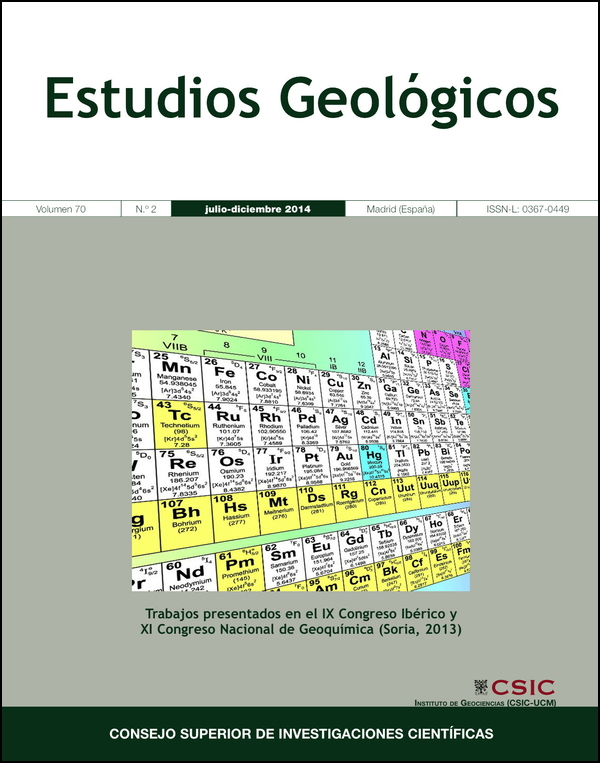Thermal effects of the Santa Eulália Plutonic Complex (southern Portugal) on the meta-igneous and metasedimentary host rocks
DOI:
https://doi.org/10.3989/egeol.41730.322Keywords:
Thermal effects, meta-igneous rocks, metasedimentary rocks, petrography, geochemistryAbstract
The Santa Eulália Plutonic Complex (SEPC) is a late-Variscan granitic body located in the northern part of the Ossa Morena Zone, a inner zone of the Variscan Iberian Massif. The SEPC host rocks are composed of meta-igneous and metasedimentary units, from Upper Proterozoic to Paleozoic ages, with a NW-SE structure, cross-cut by the SEPC. The SEPC host rocks, with low grade metamorphism show well preserved primary sedimentary or igneous mineralogical, textural and structural features. The thermal effect induced by the SEPC is restricted to the roof pendants. At N and NE of the SEPC, textures and paragenesis resulting from thermal metamorphism, are not related to the SEPC intrusion but to a previous magmatism, controlled by the NW-SE regional anisotropies. The restriction of the thermal effects to the pluton roof may be caused by a combination of several interrelated factors: higher volume of granitic mass, thermal effect by advection of fluids and longer period of prevalence of high thermal conditions. The geochemical study of SEPC host rocks shows the heterogeneous character and diversity of metasedimentary, igneous and meta-igneous rocks. The whole rock geochemical data indicate that all the metasedimentary lithologies derived from an upper continental crustal source and the igneous and meta-igneous rocks show no evidence of metasomatic effects by the SEPC emplacement.
Downloads
References
Araújo, A.; Piçarra Almeida, J.; Borrego, J.; Pedro, J. & Oliveira, J.T. (2013). As regiões centro e sul da Zona de Ossa Morena. In: Geologia de Portugal, Volume I - Geologia Pré-mesozóica de Portugal (Dias, R.; Araújo, A.; Terrinha, P. & Kullerberg, J.C., eds.). Escolar Editora, Lisboa, 509–549.
Evenson, N.M.; Hamilton, P.J. & O’Nions, R.K. (1978). Rare earth abundances in chondrite meteorites. Geochimica et Cosmochimica Acta, 42: 1199–1212. http://dx.doi.org/10.1016/0016-7037(78)90114-X
Fonseca, P.; Munhá, J.; Pedro, J.; Rosas, F.; Moita, P.; Araújo, A. & Leal, N. (1999). Variscan ophiolites and high-pressure metamorphism in Southern Iberia. Ofioliti, 24 (2): 259–268.
Gonçalves, F. (1971). Subscidios para o conhecimento geológico do Nordeste Alentejano. Memórias dos Serviços Geológicos de Portugal, 18 (Nova Série): 1–62.
Gonçalves, F. (1972) Carta Geológica de Portugal. 1:50000, Folha 33-C – Campo Maior. Serviços Geológicos de Portugal, Lisboa, 49 pp.
Gonçalves, F. (1975) Carta Geológica de Portugal. 1:50000, Folha 32-D – Sousel. Serviços Geológicos de Portugal, Lisboa, 49 pp.
Hoffman, E.L. (1992). Instrumental Neutron Activation in Geoanalysis. Journal of Geochemical Exploration, 44: 297–319. http://dx.doi.org/10.1016/0375-6742(92)90053-B
Lopes, J.M.C.; Lopes, J.L. & Lisboa, J.V. (1997). Caracterização petrográfica e estrutural dos granitos róseos do Complexo Plutónico de Monforte – Santa Eulália (NE-Alentejo, Portugal). Estudos, notas e trabalhos, Instituto Geológico e Mineiro, 39: 141–157.
Lopes, J.M.C.; Munhá, J.; Wu, C.T. & Oliveira, V.M.J. (1998). O Complexo Plutónico de Monforte-Santa Eulália (Alentejo-NE, Portugal Central): caracterização geoquímica e considerações petrogenéticas. Comunicações do Instituto Geológico e Mineiro, 83: 127–142.
Menéndez, L.G.; Azor, A.; Pereira, M.D. & Acosta, A. (2006). Petrogénesis de plutón de Santa Eulália (Alto Alentejo, Portugal). Revista de la Sociedad Geológica de España, 19 (1–2): 69–86.
Moita, P.; Munhá, J.; Fonseca, P.; Pedro, J.; Tassinari, C.; Araújo, A. & Palácios, T. (2005). Phase equilibria and geochronology of Ossa-Morena eclogites. In: Actas IV Semana de Geoquímica – VIII Congresso de Geoquímica dos Países de Língua Portuguesa, 2: 471–474.
Oliveira, J.T.; Oliveira, V. & Piçarra, J.M. (1991). Traços gerais da evolução tectono-estratigráfica da Zona de Ossa Morena, em Portugal. Cuadernos do Laboratorio Xeoloxico de Laxe, 16: 221-250.
Oliveira, J.T.; Pereira, E.; Ramalho, M.; Antunes, M.T. & Monteiro, J.H. (1992). Carta Geológica de Portugal. 1:500000. Laboratório Nacional de Energia e Geologia. http://geoportal.lneg.pt/arcgis/rest/services/CGP500K/MapServer
Pereira, M.F.; Chichorro, M.; Solá, A.R.; Silva, J.B.; Sánchez-García, T. & Bellido, F. (2011). Tracing the Cadomian magmatism with detrital/inherited zircon ages by in-situ U-Pb SHRIMP geochronology (Ossa-Morena Zone, SW Iberian Massif). Lithos, 123: 204–217. http://dx.doi.org/10.1016/j.lithos.2010.11.008
Pereira, M.F.; Silva, J.B.; Solá, A.R. & Chichorro, M. (2013). Nordeste Alentejano. In: Geologia de Portugal, Volume I- Geologia Pré-mesozóica de Portugal (Dias, R.; Araújo, A.; Terrinha, P. & Kullerberg, J.C., eds.). Escolar Editora. Lisboa, 493–508.
Quesada, C.; Fonseca, P.; Munhá, J.; Oliveira, J. & Ribeiro, A. (1994). The Beja-Acebuches Ophiolite (Southern Iberia Variscan Foldbelt): geological characterization and geodynamic significance. Boletín Geológico y Minero de España, 105 (1): 3–49.
Ribeiro, A.; Munhá, J.; Dias, R.; Mateus, A.; Pereira, E.; Ribeiro, L.; Fonseca, P.; Araújo, A.; Oliveira, T.; Romão, J.; Chaminé, H.; Coke, C. & Pedros, J. (2007). Geodynamic evolution of the SW Europe Variscides. Tectonics, 26: TC6009. http://dx.doi.org/10.1029/2006TC002058
Ribeiro, A.; Munhá, J.; Fonseca, P.; Araújo, A.; Pedro, J.; Mateus, A.; Tassinari, C.; Machado, G. & Jesus, A. (2010). Variscan ophiolite belts in the Ossa-Morena Zone (Southwest Iberia): Geological characterization and geodynamic significance. Gondwana Research, 17: 408–421. http://dx.doi.org/10.1016/j.gr.2009.09.005
Schermerhorn, L.J.G.; Priem, H.N.A.; Boelrijk, N.A.I.M.; Hebeda, E.H.; Verdurmen, E.A. & Verschure, R.H. (1978). Age and Origin of the Messejana Dolerite Fault-Dike System (Portugal and Spain) in the Light of the Opening of the North Atlantic Ocean. Journal of Geology, 86 (3): 229–309. http://dx.doi.org/10.1086/649692
Published
How to Cite
Issue
Section
License
Copyright (c) 2014 Consejo Superior de Investigaciones Científicas (CSIC)

This work is licensed under a Creative Commons Attribution 4.0 International License.
© CSIC. Manuscripts published in both the print and online versions of this journal are the property of the Consejo Superior de Investigaciones Científicas, and quoting this source is a requirement for any partial or full reproduction.
All contents of this electronic edition, except where otherwise noted, are distributed under a Creative Commons Attribution 4.0 International (CC BY 4.0) licence. You may read the basic information and the legal text of the licence. The indication of the CC BY 4.0 licence must be expressly stated in this way when necessary.
Self-archiving in repositories, personal webpages or similar, of any version other than the final version of the work produced by the publisher, is not allowed.















